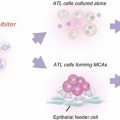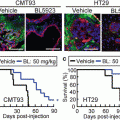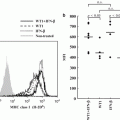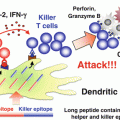Peptide dose
Number of cases
RECIST evaluationa
Decreased tumor marker PIVKA-II
CTL frequencyb
0.3 mg
8
SD 3, PD 5
0/8 (0 %)
7.5
1.0 mg
6
SD 4, PD 2
2/5 (40 %)
31.5
3.0 mg
6
SD 5, PD 1
3/5 (60 %)
70.5
10 mg
7
SD 4, PD 3
1/5 (20 %)
69
30 mg
6
PR 1, SD 3, PD 2
3/6 (50 %)
92.5
Total
33
PR 1, SD 19, PD 13 (PR + SD 60.6 %)
9/29 (31 %)
23
To determine whether the GPC3 peptide vaccine could induce a specific immune response, we evaluated the GPC3 peptide-specific immune responses by ex vivo interferon (IFN)-γ Enzyme-Linked ImmunoSpot (ELISPOT) assay using PBMCs obtained from all patients before and after each vaccination. We found that the GPC3 peptide vaccine induced a GPC3-specific CTL response in 30 of the 33 patients (91 %). GPC3-specific CTL frequency increased in a peptide dose-dependent manner (Table 11.1). Generally, CTLs for some tumor antigens cannot be directly detected ex vivo; they can be detected only after expansion by repeated in vitro stimulation with the antigenic peptide on appropriate antigen-presenting cells. This finding can be attributed to the sensitivity of the assay and the low frequency of tumor antigen-specific CTLs. Surprisingly, GPC3-specific CTLs were detected directly ex vivo without in vitro peptide stimulation in almost all patients after GPC3 peptide vaccination.
Vaccination with synthetic peptides occasionally induces ineffective CTL responses due to various underlying mechanisms (Yamshchikov et al. 2001; Matsui et al. 1995; Falo et al. 1992; Amoscato et al. 1998; Chen et al. 1999; Meadows et al. 1997). One possible mechanism is a low affinity of responding T cells such that they recognize only target cells pulsed with high concentrations of the peptide and not tumor cells expressing the relevant epitopes at lower copy numbers. Alternatively, some antigen epitopes were not expressed on the surface of tumor cells (So et al. 2007; Sorensen et al. 2009). When evaluating T cell responses to peptide vaccines, it is important to confirm that responding CTLs lyse human cancer cells. Then, we established several GPC3 peptide-specific CTL clones in PBMCs obtained from vaccinated patients by single cell sorting using a Dextramer® and CD107a antibody. These CTL clones had high avidity with a recognition efficiency of 1010 or 1011 M resulting in 50 % cytotoxicity, and could recognize HCC cell lines expressing GPC3 in an HLA-class I-restricted manner. We provided substantial evidence that CTLs displayed not only high avidity, but also natural antigen-specific killing activity against HCC cells that could be induced in HCC patients by the peptide vaccine (Yoshikawa et al. 2011). A tumor biopsy was performed with informed consent in seven patients for evaluation of infiltration of CD8-positive T cells by immunohistochemical staining. In five of seven cases, infiltration of CD8-positive T cells into the tumor was increased after vaccination.
We also examined prognostic factors in the trial. We showed that GPC3-specific CTL frequency could be a predictive marker of GPC3 peptide vaccination effects. We compared patients with GPC3-specfic CTL frequencies ≥50 (n = 15) with those with GPC3-specific CTL frequencies <50 (n = 18) and found no significant difference in clinical background. We found a significant difference (P = 0.004) only for vaccine consumption (≥1.0 vs. <1.0 mg). Analysis of all 33 patients showed that the median OS was 12.2 months (95 % CI 6.5–18.0) in patients with GPC3-specific CTL frequencies ≥50, compared with 8.5 months (95 % CI 3.7–13.1) in those with GPC3-specfic CTL frequencies <50 (P = 0.033). In conclusion, this phase I clinical trial of a GPC3-derived peptide vaccine showed the vaccination to be safe and indicated a plethora of immunologic responses. This study also showed that GPC3-specific CTL frequency was correlated with OS in patients with advanced HCC who received the GPC3 peptide vaccine. These observations suggest that GPC3-derived peptide vaccines represent a novel therapy for patients with HCC, with the potential to improve OS.
11.4 Pilot Study of the GPC3-Derived Peptide Vaccine for Advanced HCC
In the phase I trial, we demonstrated an increase in GPC3 peptide-specific CTLs in peripheral blood, and identified numerous CD8-positive T cell-infiltrated tumors after GPC3 peptide vaccination. However, we could not confirm that the tumor-infiltrating lymphocytes detected after vaccination were GPC3 peptide-specific CTLs. To determine whether tumor-infiltrating lymphocytes are indeed GPC3 peptide-specific CTLs, we are currently initiating a pilot study of liver biopsies carried out before and after GPC3 peptide vaccination for advanced HCC (UMIN-CTR: 000005093). In this study, we provide evidence of immunologic responses from two cases. In one case, we performed a pathological study, including autopsy, of a patient, which revealed remarkable tumor lysis immediately after the second vaccination (Sawada et al. 2013). In the other case, we provide evidence that GPC3 peptide-specific CTLs have infiltrated the tumor tissue after peptide vaccination (manuscript in preparation). These results serve as a proof-of concept for GPC3 peptide vaccine therapy.
11.5 Investigator-Initiated Phase II Trial of the GPC3-Derived Peptide Vaccine for Treatment of HCC
Immunotherapy is expected to contribute toward cancer therapy, especially during the early stages or in recurrence prevention. Therefore, we have begun an investigator-initiated phase II clinical trial of the GPC3-derived peptide vaccine as an adjuvant therapy for patients with HCC (UMIN-CTR: 000002614). Forty patients with initial HCC who had undergone surgery or radiofrequency ablation were enrolled in this phase II, open-label, single-arm trial. Ten 3 mg GPC3-derived peptide vaccinations were performed over 1 year following curative treatment. The primary endpoints were the 1- and 2-year recurrence rates. The secondary endpoints were immunologic responses. Currently, the correlation between the time of recurrence and immunologic responses is being analyzed (Table 11.2).
Table 11.2
Ongoing investigator-initiated clinical trials of glypican-3-derived peptide vaccines
Phase | Number of cases | Cancer type | Subject | Primary endpoint | Secondary endpoint |
|---|---|---|---|---|---|
II | 40 | Hepatocellular carcinoma | After surgery or radiofrequency ablation | 1- and 2-year recurrence rates | Immunologic responses |
Pilot study | 20 | Hepatocellular carcinoma | Advanced | Immunologic responses (T cell infiltration into tumor) | Clinical responses |
II | 130 | Ovarian clear cell carcinoma | Advanced, remission, or combined with chemotherapy | Disease control rate, 2-year recurrence rate | Clinical responses, quality of life |
I | 15 or 30 | Pediatric cancer except for leukemia | Advanced or remission | Dose limiting toxicity | Safety and immunologic responses |
11.6 The Application of GPC3-Derived Peptide Vaccine for Other GPC3-Expressing Cancers
GPC3 is over-expressed in other malignant tumors, such as melanoma, Wilms’ tumor, hepatoblastoma, yolk sac tumor, ovarian clear cell carcinoma, and lung squamous cell carcinoma (Nakatsura et al. 2004a; Saikali and Sinnett 2000; Toretsky et al. 2001; Maeda et al. 2009; Aviel-Ronen et al. 2008). In the phase I trial, we established several GPC3 peptide-specific CTL clones from vaccinated patients with HCC. We investigated whether the GPC3-based immunotherapy could be applied to other GPC3-expressing cancers including melanoma, clear cell carcinoma of the ovary, and pediatric cancer using a GPC3 peptide-specific CTL clone. The CTL clone recognized naturally processed GPC3-derived peptide on ovarian clear cell carcinoma cells in a HLA class I-restricted manner. Moreover, we confirmed that the level of GPC3 expression was responsible for CTL recognition and that a subtoxic chemotherapeutic dose caused tumor cells to become more susceptible to the cytotoxic effect of CTL (Suzuki et al. 2011). Based on these results, we are currently conducting an investigator-initiated phase II trial with a GPC3-derived peptide vaccine in ovarian clear cell carcinoma patients (UMIN-CTR: 000003696). In this study, two cases with chemotherapy-refractory ovarian clear cell carcinoma achieved a significant clinical response (Suzuki et al. 2013). Furthermore, we have begun an investigator-initiated phase I trial with a GPC3-derived peptide vaccine in pediatric cancer patients diagnosed with hepatoblastoma, nephroblastoma, and yolk sac tumor (UMIN-CTR: 000006357) (Table 11.2).
11.7 Development of a Novel Strategy for Peptide-Specific Cancer Immunotherapy
Although the peptide vaccine is a potentially attractive treatment modality, the anti-tumor effects of the peptide vaccine alone are not sufficiently dramatic for advanced HCC. Therefore, the creation of an innovative strategy to link the anti-tumor immune response with the clinical response and to enhance the power of antigen-specific cancer immunotherapy is urgently required. Cellular immunotherapy of solid and hematopoietic malignancies is regarded as a promising approach to deal with common relapse or resistance to conventional treatments. However, isolation and expansion of functionally active T cells is difficult. Developing a new method of CTL expansion may be useful in addressing this problem. We investigated the efficiency of a new method to induce expansion of GPC3 peptide-specific CTLs for adoptive immunotherapy. The expansion of CTLs from PBMCs of vaccinated patients with advanced HCC yields cell numbers sufficient for adoptive transfer (manuscript in preparation).
Stay updated, free articles. Join our Telegram channel

Full access? Get Clinical Tree







